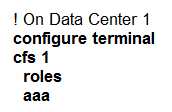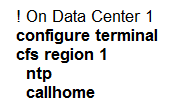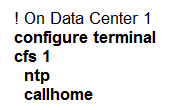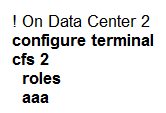A customer data center is configured for distribution of user roles, call home, and NTP. The data center was split into two geographically separate locations called
DC1 and DC2. The requirement is for the user role configurations to be distributed in DC1 and for NTP and call home features to be constrained to DC2. Which two configuration sets must be used to meet these requirements? (Choose two.)
A.
B.
C.
D.
E.
BD
Reference:
https://www.cisco.com/en/US/docs/storage/san_switches/mds9000/sw/rel_3_x/configuration/guides/cli_3_4_x/cfs.html#wp1306478

Refer to the exhibit. An engineer must distribute all the host ports to use all eight configured FEX uplinks. The solution must minimize disruption if an uplink fails.
Which action accomplishes this objective?
B
A fabric interface that fails in the port channel does not trigger a change to the host interfaces. Traffic is automatically redistributed across the remaining links in the port channel fabric interface. If all links in the fabric port channel go down, all host interfaces on the FEX are set to the down state.
Reference:
https://www.cisco.com/c/en/us/td/docs/switches/datacenter/nexus2000/sw/configuration/guide/ b_Cisco_Nexus_2000_Series_Fabric_Extender_Software_Configuration_Guide_Release_4_2/ b_Cisco_Nexus_2000_Series_Fabric_Extender_Software_Configuration_Guide_Release_4_2_chapter_011.html
An engineer must start a software upgrade on a Cisco Nexus 5000 Series Switch during a zone merge. What is the result of this action?
A
Reference:
https://www.cisco.com/c/en/us/td/docs/switches/datacenter/nexus5000/sw/upgrade/503_N1_1/n5000_upgrade_downgrade_503_n1_1.html
A network engineer needs to upgrade the EPLDs of the fabric modules for a Cisco MDS director-class switch. In which order are components reloaded during the process?
A
To update all EPLDs sequentially with a single command, use the install all epld command with the module all fan-module all xbar all options. After each module is upgraded, it is power cycled to load the EPLD update.
Reference:
https://www.cisco.com/c/en/us/td/docs/switches/datacenter/mds9000/sw/8_x/release_notes/epld/epld_rn_8_4_1a.html#pgfId-321469
What is a characteristic of EPLD updates on Cisco MDS 9000 Series Switches?
B
Reference:
https://www.cisco.com/c/en/us/td/docs/switches/datacenter/nexus9000/sw/92x/epld-rn/nxos_n9K_epldRN_924.html
The EPLD update of the supervisor module has been scheduled for several Cisco MDS 9000 Series Switches. What will be the impact of the update?
A
An EPLD update of the supervisor module of Fabric Switches (Cisco MDS 9100, Cisco MDS 9200, and Cisco MDS 9300 Series switches) is disruptive since there is no redundant supervisor to take over while the update is in progress. All traffic through the system is stopped while updating and the switch is power cycled after the upgrade has completed. The update may take up to 30 minutes to complete.
Reference:
https://www.cisco.com/c/en/us/td/docs/switches/datacenter/mds9000/sw/6_2/release/notes/epld/epld_rn.html
A network engineer configures a converged network adapter (CNA) and must associate a virtual Fibre Channel 7 interface to VSAN 7. The CNA is connected to the interface Eth1/7, and VLAN 700 is mapped to the VSAN. Which configuration must be applied to create the virtual Fibre Channel interface and associate it with the Ethernet physical interface?
A
Reference:
https://www.cisco.com/c/en/us/td/docs/switches/datacenter/nexus5000/sw/fcoe/421_n1_1/b_Cisco_n5k_fcoe_config_gd_re_421_n1_1/
Cisco_n5k_fcoe_config_gd_re_421_n1_1_chapter4.html
A company is running a pair of Cisco Nexus 7706 Series Switches as part of a data center segment. All network engineers have restricted read-write access to the core switches. A network engineer must add a new FCoE VLAN to allow traffic from servers toward FCoE storage. Which set of actions must be taken to meet these requirements?
D
User roles contain rules that define the operations allowed for the user who is assigned the role. Each user role can contain multiple rules and each user can have multiple roles. For example, if role1 allows access only to configuration operations, and role2 allows access only to debug operations, then users who belong to both role1 and role2 can access configuration and debug operations. You can also limit access to specific VLANs, virtual routing and forwarding instances (VRFs), and interfaces.
The Cisco NX-OS software provides four default user roles:
ג€¢network-adminג€"Complete read-and-write access to the entire NX-OS device (only available in the default VDC)
ג€¢network-operatorג€"Complete read access to the entire NX-OS device (only available in the default VDC)
ג€¢vdc-adminג€"Read-and-write access limited to a VDC
ג€¢vdc-operatorג€"Read access limited to a VDC
Note: You cannot change the default user roles.
Reference:
https://www.cisco.com/c/en/us/td/docs/switches/datacenter/sw/4_1/nx-os/security/configuration/guide/sec_nx-os-cfg/sec_rbac.html#wp1431408
Which communication method does NFS use for requests between servers and clients?
B
The Network File System (NFS) is an application where the user can view, store and update the files on a remote device. NFS allows the user to mount all or a part of a file system on a server. NFS uses Remote Procedure Calls (RPC) to route requests between the users and servers.
Reference:
https://www.cisco.com/c/en/us/td/docs/routers/nfvis/config/3-7-1/nfvis-config-guide-3-7-1/nfvis-config-guide_chapter_01100.html
What is an advantage of NFSv4 over Fibre Channel Protocol?
C
Reference:
https://www.rcannings.com/san-storage-fc-vs-fcoe-vs-iscsi/